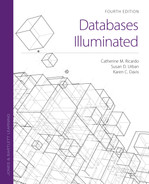9.1 Rationale for the Object-Oriented (OO) Data Model
The traditional relational model, in which data is represented as tables having rows of single-valued attributes, is limited in its ability to represent the complex data and relationships needed for advanced applications. Just as the entity-relationship (ER) model was found to be lacking in its ability to represent a conceptual model for advanced applications such as software engineering, social media, and geographical information systems, the traditional relational model lacks the data structures to support the information requirements for these applications.
OO programming languages, beginning with Simula and Smalltalk, presented an alternate way of designing programs in which data structures and their operations had primary importance. OO programming is widely recognized as a method for producing highly reliable, reusable code. The promise of the early OO languages, the popularity of the OO languages C++, C#, Python, Ruby, Perl, PHP, LISP, and Java, and the addition of OO capabilities to other languages such as Visual Basic.NET influenced database modeling as well. The challenge of extending these languages to databases is to move from the temporary objects created and manipulated by programs to persistent objects that can be stored in a database.
Object-oriented database management systems (OODBMSs) allow the database designer to create highly complex, interrelated objects and to give them persistence. As discussed in Section 1.6, vendors of relational database systems have responded to the challenges of object-oriented (OO) systems by extending the relational model to incorporate OO concepts while retaining the underlying relational structures, creating hybrid object-relational database management systems (ORDBMSs). There is considerable overhead involved in mapping the objects used in OO applications to the table structures that the relational model supports. Because relational database vendors addressed some of the limitations of relational databases, and because users who have a heavy investment in relational systems were disinclined to migrate to an entirely new paradigm, the popularity of OO databases was initially limited. However, OODBMSs are gaining in popularity, particularly in environments having highly complex data requirements.
